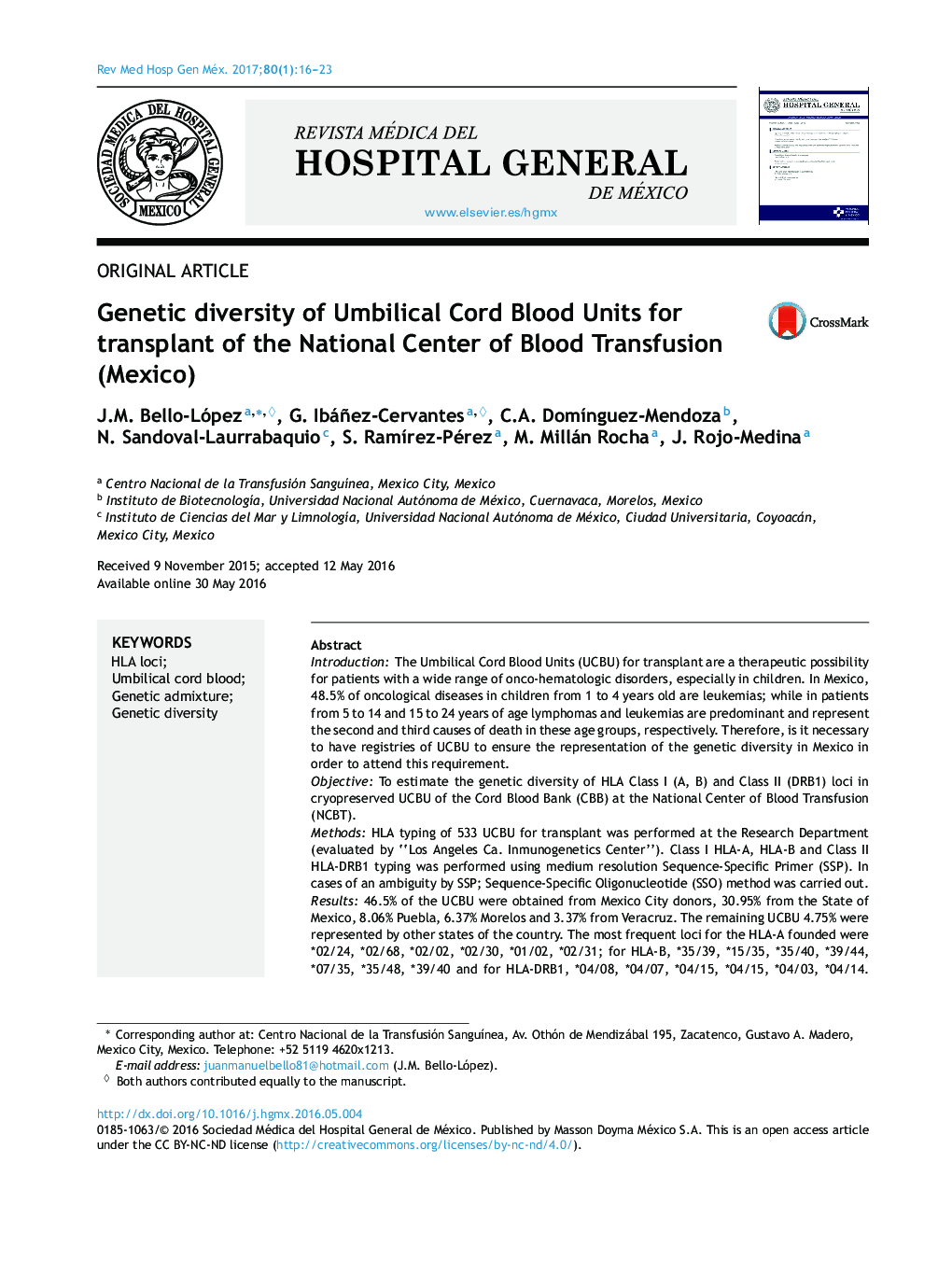| کد مقاله | کد نشریه | سال انتشار | مقاله انگلیسی | نسخه تمام متن |
|---|---|---|---|---|
| 5683761 | 1408945 | 2017 | 8 صفحه PDF | دانلود رایگان |
IntroductionThe Umbilical Cord Blood Units (UCBU) for transplant are a therapeutic possibility for patients with a wide range of onco-hematologic disorders, especially in children. In Mexico, 48.5% of oncological diseases in children from 1 to 4 years old are leukemias; while in patients from 5 to 14 and 15 to 24 years of age lymphomas and leukemias are predominant and represent the second and third causes of death in these age groups, respectively. Therefore, is it necessary to have registries of UCBU to ensure the representation of the genetic diversity in Mexico in order to attend this requirement.ObjectiveTo estimate the genetic diversity of HLA Class I (A, B) and Class II (DRB1) loci in cryopreserved UCBU of the Cord Blood Bank (CBB) at the National Center of Blood Transfusion (NCBT).MethodsHLA typing of 533 UCBU for transplant was performed at the Research Department (evaluated by “Los Angeles Ca. Inmunogenetics Center”). Class I HLA-A, HLA-B and Class II HLA-DRB1 typing was performed using medium resolution Sequence-Specific Primer (SSP). In cases of an ambiguity by SSP; Sequence-Specific Oligonucleotide (SSO) method was carried out.Results46.5% of the UCBU were obtained from Mexico City donors, 30.95% from the State of Mexico, 8.06% Puebla, 6.37% Morelos and 3.37% from Veracruz. The remaining UCBU 4.75% were represented by other states of the country. The most frequent loci for the HLA-A founded were *02/24, *02/68, *02/02, *02/30, *01/02, *02/31; for HLA-B, *35/39, *15/35, *35/40, *39/44, *07/35, *35/48, *39/40 and for HLA-DRB1, *04/08, *04/07, *04/15, *04/15, *04/03, *04/14. The genetic distances analysis showed that the top five populations analyzed in this study are significatively different from each other.ConclusionsThe majority of the genotypes found suggest Amerindian and European origins and in a lesser proportion Oriental and African. The NCBT is therefore establishing agreements with different states of Mexico to promote the donation of UCBU in order to enrich the genetic diversity in the archives of the NCBT.
ResumenIntroducciónLas Unidades de Sangre de Cordón Umbilical (USCU) para trasplante constituyen una posibilidad terapéutica para pacientes con trastornos onco-hematológicos, especialmente en niños. En México 48.5% de las enfermedades oncológicas en niños de 1 a 4 años son las leucemias; mientras que en pacientes de 5-14 y 15-24 años de edad, los linfomas y leucemias son predominantes y representan la segunda y tercera causa de muerte en estos grupos de edad, respectivamente. Por lo anterior, es necesario contar con registros de UCBU para asegurar la diversidad genética de estas unidades en el paÃs.ObjetivoEstimar la diversidad genética del HLA de Clase I (A, B) y Clase II (DRB1) en USCU criopreservadas en el Banco de Sangre de Cordón (BSC) del Centro Nacional de Transfusión SanguÃnea (CNTS).MétodoLa tipificación del HLA de 533 UCBU se llevó a cabo en el Departamento de Investigación (evaluado por “El Centro de Inmunogenética de Los Angeles Ca.”). La tipificación del HLA de Clase I y II se realizó mediante el método de mediana resolución “Secuencia-Cebador-EspecÃfico” (SSP). En los casos de ambigüedades por SSP; se empleó el método de Oligonucleótido-Secuencia-EspecÃfico (SSO).ResultadosEl 46.5% de las UCBU fueron colectadas en la Ciudad de México, 30.95% en el Estado de México, 8.06% Puebla, 6.37% Morelos y 3.37% de Veracruz. El resto de las UCBU (4.75%) están representadas por otros estados del paÃs. El loci más frecuente encontrado para HLA-A fue *02/24, *02/68, *02/02, *02/30, *01/02, *02/31; para HLA-B, *35/39, *15/35, *35/40, *39/44, *07/35, *35/48, *39/40 y para el HLA-DRB1 fueron *04/08, *04/07, *04/15, *04/15, *04/03, *04/14. El análisis de las distancias genéticas mostró que las cinco poblaciones analizadas son significativamente diferentes unas de otrasConclusionesLa mayorÃa de los genotipos encontrados sugieren orÃgenes Amerindios y Europeos y en menor proporción Orientales y Africanos. Por lo anterior, el CNTS está estableciendo convenios con los diferentes estados de la República Mexicana para promover la donación de USCU con el fin de enriquecer la diversidad genética en sus archivos.
Journal: Revista Médica del Hospital General de México - Volume 80, Issue 1, JanuaryâMarch 2017, Pages 16-23
